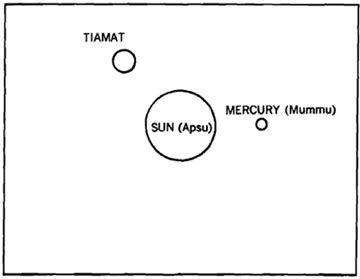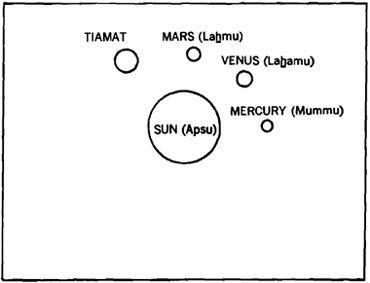The 12th Planet (34 page)
Authors: Zecharia Sitchin
Tags: #Non-Fiction, #Gnostic Dementia, #Fringe Science, #Retail, #Archaeology, #Ancient Aliens, #History

Among the texts uncovered by Henry Layard in the ruins of the library of Ashurbanipal in Nineveh, there was one that told a tale of Creation not unlike the one in the Book of Genesis. The broken tablets, first pieced together and published by George Smith in 1876
(The Chaldean Genesis),
conclusively established that there indeed existed an Akkadian text, written in the Old Babylonian dialect, that related how a certain deity created Heaven and Earth and all upon Earth, including Man.
A vast literature now exists that compares the Mesopotamian text with the biblical narrative. The Babylonian deity's work was done, if not in six "days," then over the span of six tablets. Parallel to the biblical God's seventh day of rest and enjoyment of his handiwork, the Mesopotamian epic devotes a seventh tablet to the exaltation of the Babylonian deity and his achievements. Appropriately, L. W. King named his authoritative text on the subject
The Seven Tablets of Creation.
Now called "The Creation Epic," the text was known in antiquity by its opening words,
Enuma Elish
("When in the heights"). The biblical tale of Creation begins with the creation of Heaven and Earth; the Mesopotamian tale is a true cosmogony, dealing with prior events and taking us to the beginning of time:
Enuma elish fa nabu shamamu
When in the heights Heaven had not been named
Shaplitu ammatum shuma fa zakrat
And below, firm ground [Earth] had not been called
It was then, the epic tells us, that two primeval celestial bodies gave birth to a series of celestial "gods." As the number of celestial beings increased, they made great noise and commotion, disturbing the Primeval Father. His faithful messenger urged him to take strong measures to discipline the young gods, but they ganged up on him and robbed him of his creative powers. The Primeval Mother sought to take revenge. The god who led the revolt against the Primeval Father had a new suggestion: Let his young son be invited to join the Assembly of the Gods and be given supremacy so that he might go to fight singlehanded the "monster" their mother turned out to be.
Granted supremacy, the young god—Marduk, according to the Babylonian version—proceeded to face the monster, and, after a fierce battle, vanquished her and split her in two. Of one part of her he made Heaven, and of the other, Earth.
He then proclaimed a fixed order in the heavens, assigning to each celestial god a permanent position. On Earth he produced the mountains and seas and rivers, established the seasons and vegetation, and created Man. In duplication of the Heavenly Abode, Babylon and its towering temple were built on Earth. Gods and mortals were given assignments, commandments, and rituals to be followed. The gods then proclaimed Marduk the supreme deity, and bestowed on him the "fifty names"—the prerogatives and numerical rank of the Enlilship.
As more tablets and fragments were found and translated, it became evident that the text was not a simple literary work: It was the most hallowed historical-religious epic of Babylon, read as part of the New Year rituals. Intended to propagate the supremacy of Marduk, the Babylonian version made him the hero of the tale of Creation. This, however, was not always so. There is enough evidence to show that the Babylonian version of the epic was a masterful religious-political forgery of earlier Sumerian versions, in which Anu, Enlil, and Ninurta were the heroes.
No matter, however, what the actors in this celestial and divine drama were called, the tale is certainly as ancient as Sumerian civilization. Most scholars see it as a philosophic work—the earliest version of the eternal struggle between good and evil—or as an allegorical tale of nature's winter and summer, sunrise and sunset, death and resurrection.
But why not take the epic at face value, as nothing more nor less than the statement of cosmologic facts as known to the Sumerians, as told them by the Nefilim? Using such a bold and novel approach, we find that the "Epic of Creation" perfectly explains the events that probably took place in our solar system.
The stage on which the celestial drama of
Enuma Elish
unfolds is the primeval universe. The celestial actors are the ones who create as well as the ones being created. Act I:
When in the heights Heaven had not been named,
And below, Earth had not been called;
Naught, but primordial APSU, their Begetter,
MUMMU, and TIAMAT—she who bore them all;
Their waters were mingled together.
No reed had yet formed, no marshland had appeared.
None of the gods had yet been brought into being,
None bore a name, their destinies were undetermined;
Then it was that gods were formed in their midst.
With a few strokes of the reed stylus upon the first clay tablet—in nine short lines—the ancient poet-chronicler manages to seat us in front row center, and boldly and dramatically raise the curtain on the most majestic show ever: the Creation of our solar system.
In the expanse of space, the "gods"—the planets—are yet to appear, to be named, to have their "destinies"—their orbits—fixed. Only three bodies exist: "primordial AP.SU" ("one who exists from the beginning"); MUM.MU ("one who was born"); and TIAMAT ("maiden of life"). The "waters" of Apsu and Tiamat were mingled, and the text makes it clear that it does not mean the waters in which reeds grow, but rather the primordial waters, the basic life-giving elements of the universe.
Apsu, then, is the Sun, "one who exists from the beginning."
Nearest him is Mummu. The epic's narrative makes clear later on that Mummu was the trusted aide and emissary of Apsu: a good description of Mercury, the small planet rapidly running around his giant master. Indeed, this was the concept the ancient Greeks and Romans had of the god-planet Mercury: the fast messenger of the gods.
Farther away was Tiamat. She was the "monster" that Marduk later shattered—the "missing planet." But in primordial times she was the very first Virgin Mother of the first Divine Trinity. The space between her and Apsu was not void; it was filled with the primordial elements of Apsu and Tiamat. These "waters" "commingled," and a pair of celestial gods-planets-were formed in the space between Apsu and Tiamat.
Their waters were mingled together....
Gods were formed in their midst:
God LA
H
MU and god LA
H
AMU were brought forth;
By name they were called.
Etymologically, the names of these two planets stem from the root
L
H
M
("to make war"). The ancients bequeathed to us the tradition that Mars was the God of War and Venus the Goddess of both Love and War. LA
H
MU and LA
H
AMU are indeed male and female names, respectively; and the identity of the two gods of the epic and the planets Mars and Venus is thus affirmed both etymologically and mythologically. It is also affirmed astronomically: As the "missing planet," Tiamat was located beyond Mars. Mars and Venus are indeed located in the space between the Sun (Apsu) and "Tiamat." We can illustrate this by following the Sumerian celestial map. (Figs. 102, 103)
The process of the formation of the solar system then went on. La
h
mu and La
h
amu—Mars and Venus-were brought forth, but even
Before they had grown in age
And in stature to an appointed size—
God ANSHAR and god KISHAR were formed,
Surpassing them [in size].
As lengthened the days and multiplied the years,
God ANU became their son—of his ancestors a rival.
Then Anshar's first-born, Anu,
As his equal and in his image begot NUDIMMUD.
With a terseness matched only by the narrative's precision, Act I of the epic of Creation has been swiftly played out before our very eyes. We are informed that Mars and Venus were to grow only to a limited size; but even before their formation was complete, another pair of planets was formed. The two were majestic planets, as evidenced by their names—AN.SHAR ("prince, foremost of the heavens") and KI.SHAR ("foremost of the firm lands"). They overtook in size the first pair, "surpassing them" in stature. The description, epithets, and location of this second pair easily identify them as Saturn and Jupiter. (Fig. 104).
Some time then passed ("multiplied the years"), and a third pair of planets was brought forth. First came ANU, smaller than Anshar and Kishar ("their son"), but larger than the first planets ("of his ancestors a rival" in size). Then Anu, in turn, begot a twin planet, "his equal and in his image." The Babylonian version names the planet NUDIMMUD, an epithet of Ea/Enki. Once again, the descriptions of the sizes and locations fit the next known pair of planets in our solar system, Uranus and Neptune.
There was yet another planet to be accounted for among these outer planets, the one we call Pluto. The "Epic of Creation" has already referred to Anu as "Anshar's first-born," implying that there was yet another planetary god "born" to Anshar/Saturn. The epic catches up with this celestial deity later on, when it relates how Anshar sent out his emissary GAGA on various missions to the other planets. Gaga appears in function and stature equal to Apsu's emissary Mummu; this brings to mind the many similarities between Mercury and Pluto. Gaga, then, was Pluto; but the Sumerians placed Pluto on their celestial map not beyond Neptune, but next to Saturn, whose "emissary," or satellite, it was. (Fig. 105)
As Act I of the "Epic of Creation" came to an end, there was a solar system made up of the Sun and nine planets:
SUN
—
Apsu,
"one who existed from the beginning."
MERCURY
—Mummu, counselor and emissary of Apsu.
VENUS
—La
h
amu, "lady of battles."
MARS
—La
h
mu, "deity of war."
??
—
Tiamat,
"maiden who gave life."
JUPITER
—Kishar, "foremost of firm lands."
SATURN
—Anshar, "foremost of the heavens."
PLUTO
—Gaga, counselor and emissary of Anshar.
URANUS
—
Anu,
"he of the heavens."
NEPTUNE
—
Nudimmud (Ea),
"artful creator."

Fig. 102. I. In the Beginning: Sun, Mercury, "Tiamat."

